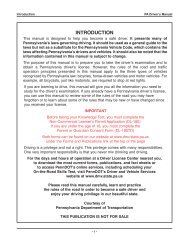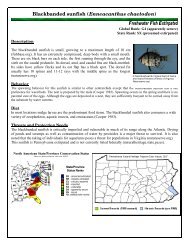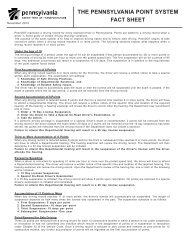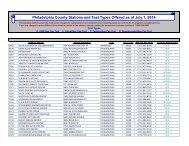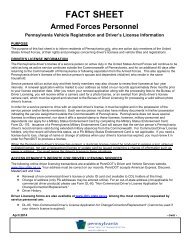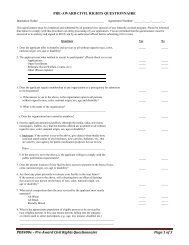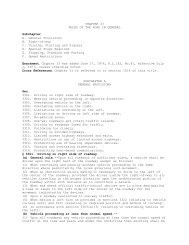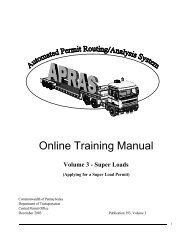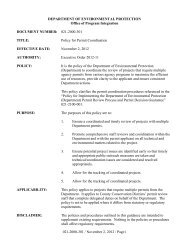fundamentals of driving a school bus - PennDOT Driver and Vehicle ...
fundamentals of driving a school bus - PennDOT Driver and Vehicle ...
fundamentals of driving a school bus - PennDOT Driver and Vehicle ...
- No tags were found...
You also want an ePaper? Increase the reach of your titles
YUMPU automatically turns print PDFs into web optimized ePapers that Google loves.
UNIT G - Fundamentals <strong>of</strong> Driving a School BusBACKINGBecause you cannot see everything behind your vehicle, backing is always dangerous, even in the bestcircumstances. This is supported by Pennsylvania <strong>school</strong> <strong>bus</strong> crash data, which indicates backing is a crashcause in over 5 percent <strong>of</strong> crashes involving <strong>school</strong> <strong>bus</strong>es as the prime vehicle. This seems high consideringthe number <strong>of</strong> times backing is required, which supports the notion it is a dangerous maneuver. Pennsylvania<strong>school</strong> <strong>bus</strong> crash data shows backing crashes are four times as likely to occur in clear weather conditions asin adverse weather conditions. This may indicate drivers are complacent with this maneuver when weatherconditions are good. ANY time you have to backup, be careful <strong>and</strong> follow the recommendations below.Avoid backing whenever you can <strong>and</strong> avoid backing a <strong>bus</strong> from a side road to a main road. Unfortunately, theremay be situations where backing is necessary, such as when you are at the end <strong>of</strong> your route <strong>and</strong> there is nobetter designated turn around area, or if you get lost on a road <strong>and</strong> encounter a bridge weight limit. If you know<strong>of</strong> a better area to turn around that would avoid backing, talk to your transportation coordinator about modifyingyour route.School <strong>bus</strong>es are also most <strong>of</strong>ten parked by backing into their location. When you park, try to park, so you willbe able to pull forward when you leave. When you have to back, follow these rules:1. Keep Students on the Bus – Keep all students on the <strong>bus</strong>. State regulation (Section 104.3(d) <strong>of</strong>Title 67) requires that if backing is required at or near a loading or unloading zone, all students must beseated on the <strong>bus</strong> during the backing. Never back a <strong>bus</strong> when students are outside, so either back upbefore drop-<strong>of</strong>f or after-pick up. Be particularly aware <strong>of</strong> students who may be late <strong>and</strong> running to catchthe <strong>bus</strong>.2. Back <strong>and</strong> Turn Toward the <strong>Driver</strong>’s Side – Plan your maneuver. Whenever possible, back towardthe driver’s side, so you can see better. Backing toward the right side is very dangerous because youcan’t see as well. If you back <strong>and</strong> turn toward the driver’s side, you can watch the rear <strong>of</strong> your vehicleby looking out the side window <strong>and</strong> in the mirror.When backing a <strong>bus</strong>, turn the top <strong>of</strong> the steering wheel toward the direction you want to go. This may takepractice.3. Look at Your Path – Look at your line <strong>of</strong> travel to be sure you know what is behind you before youbegin. Don’t take chances. Sometimes you can’t see enough with your mirrors; it’s much safer to getout <strong>and</strong> look, even if it means walking to the rear <strong>of</strong> the <strong>bus</strong> to determine whether the way is clear. Byso doing, you may prevent a serious incident. If you need to walk to the rear <strong>of</strong> the <strong>bus</strong>, set the parkingbrake, turn <strong>of</strong>f the motor <strong>and</strong> take the keys with you. Walk to the rear <strong>of</strong> the <strong>bus</strong> to determine whetherthe way is clear. Also check your clearance to the sides <strong>and</strong> overhead both in <strong>and</strong> near the path yourvehicle will take. Then reenter the vehicle, check your mirrors <strong>and</strong> start backing.4. Back Slowly <strong>and</strong> Smoothly – Always back as slowly as possible so you may make correctionsbefore you get too far <strong>of</strong>f course. Go slowly, so you can correct any steering errors more easily beforeyou get too far <strong>of</strong>f course. Going slowly means you can also stop quickly, if necessary.Pennsylvania School Bus <strong>Driver</strong>’s Manual • PUB 117 G-11



